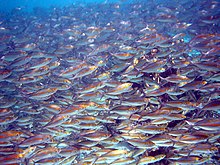Cohesion (behavior)
Cohesion (from the English cohesion : "cohesion") is behavior that occurs in natural swarms , e.g. B. in fish and birds, occurs and causes the swarm to move as a unit.
Scientists such as Craig Reynolds , who analyzed natural swarm behavior in order to model it on the computer , came to the conclusion that the phenomenon can be described by three basic rules that are observed by every individual and that generate emergent behavior at the swarm level :
- Move towards the center of those you see around you (cohesion).
- Move away as soon as someone comes too close to you ( separation ).
- Move in roughly the same direction as your neighbors ( alignment ).
Cohesive behavior refers to the endeavor of each individual to move in the middle of their neighbors. The individuals do not try to keep a certain distance from one another, as is often assumed, but concentrate on a limited number of neighbors and move in their midst.
Influences
The number of neighbors considered is limited by the individual's vision and brain capacities. So pay attention z. B. People moving through pedestrian zones affect more people at the same time than most swarms.
As ecologists working with Ashley Ward from the University of Sydney discovered, the environmental toxin nonylphenol influences the cohesive behavior of fish. Even in small quantities of only 0.5 µg / L, the substance covers the fish's own odor, which means that they keep a greater distance from one another.
Different cohesive behavior
In natural swarms, the cohesive behavior occurs in different forms. It is flexibly adapted to the defense or movement strategies of the swarms and is primarily influenced by the predators from which the swarm has to protect itself.
- Starlings try to keep roughly the same distance from each neighbor. This creates the well-known spherical shape that can be observed in migrating swarms of starlings. By keeping the starlings close to each other, it is difficult for attackers to locate a fixed target in the swarm.
- Unlike starlings, most migratory birds only concentrate on their neighbors flying in front of them, as this creates a V-formation , which has aerodynamic advantages. Migratory birds do not have to watch out for their defense against birds of prey like starlings.
See also
Individual evidence
- ↑ Craig Reynolds: Boids. September 6, 2001, accessed April 20, 2016 .
- ^ South German knowledge . 04, 2008, p. 10.
- ↑ Jake O'Shaughnessy: Soap contamination disrupts fish stocks. In: The University of Sydney (Online). October 26, 2007, accessed April 20, 2016 .
- ↑ Environmental toxins rob fish of the sense of schooling. In: Die Welt Online. October 25, 2007, accessed April 20, 2016 .
- ↑ Kerstin Viering: How migratory birds save energy. In: Berliner Zeitung . October 24, 2001, accessed June 17, 2015 .
